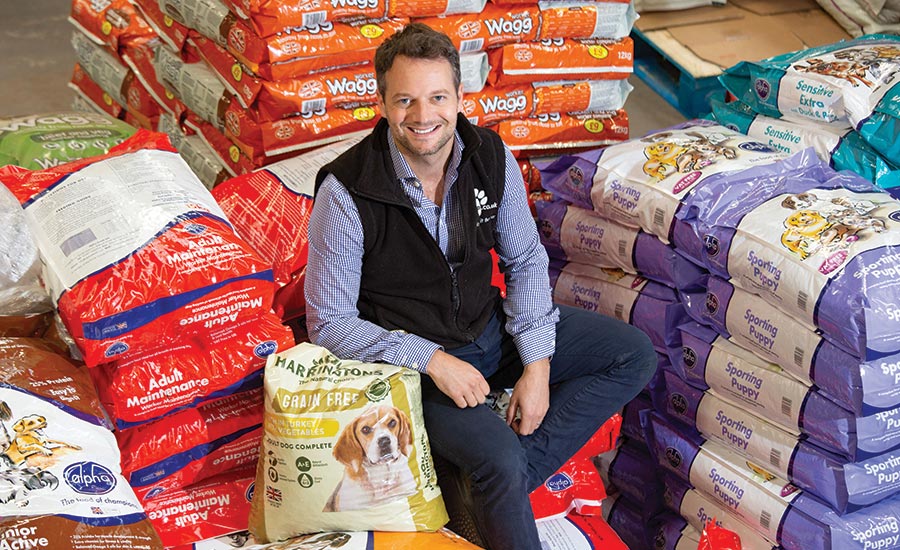Pet Food
Pet food e-commerce boom has major influence on manufacturers' operations
Online shoppers' preferences lead to faster product development and more direct-to-consumer shipping of dog and cat food

PetShop.co.uk cofounder Adam Taylor says pet food companies want more and more data from the retail site about inventory levels and product performance. Live, accurate information about your business health is imperative with e-commerce’s tight margins, he says.
Photo courtesy of PetShop.co.uk

Pet food shoppers go online to search for products they’d like to have but aren’t sure exist. Profitero says smart pet food companies watch those search terms for signs of what pet owners want next.
Photo courtesy of Getty Images

Premium treats are popular for online sales because they have higher price points and the small bags are less expensive to ship.
Photo courtesy of Getty Images

Variety in the pet food market means more changeovers. To keep things running smoothly, Bühler’s Digital Services allows processors to monitor line efficiency and plan changeover orders. Online monitoring helps Bühler head off potential problems it can’t handle in person because of limited plant visitor access during the pandemic. Bühler specialists use augmented reality glasses to help customers resolve issues as if they were on-site.
Photo courtesy of Bühler

Online shoppers have major influence on pet food trends, such as smaller bags of kibble, like this food coming out of a Bühler dryer.
Photos courtesy of Bühler

A Profitero business survey showed almost half of companies feel behind on e-commerce.
Images courtesy of Profitero

Oracle NetSuite integrates financials, inventory management, omnichannel commerce, analytics and more, allowing companies to view aggregated data or drill down to granular transaction details.
Image courtesy of Oracle NetSuite







Skyrocketing online shopping for pet food is changing significant parts of how manufacturers operate.
Processors are savvier at fighting for a larger share of the so-called digital shelf, and they are establishing lucrative long-term relationships with subscription shoppers and reacting earlier to product trends. They are increasingly internalizing parts of their distribution network to supply some consumers and sales channels themselves, adding supplemental processing equipment, warehouse space, and even their own automatic storage and retrieval systems.
Online retailer PetShop.co.uk has found that pet food brands, especially the large ones, are hungry for extensive data from the site on how to increase sales, cofounder Adam Taylor says. PetShop shares figures from its Oracle NetSuite software system on everything from how many shoppers use a discount code to precisely how much product is in stock, an especially important metric with rapidly shifting buying patterns from COVID-19.
"We're really able to help steer brands’ strategies. Working together with them is the key," Taylor says.
The further leap in online shopping during the pandemic adds to the influence that e-commerce has had on manufacturers’ operations for quite a while, including the need for flexibility and changeover efficiency to handle desired SKU variety and smaller batches, with premium products driving growth.
Plus, the search continues for packaging (and its machinery) to help products arrive on the doorstep at the highest quality, increasing the popularity of durable flexible bags for high-end kibble and lighter pouches for wet food and treats. And high pressure processing offers a new method to extend shelf life and freshness using lightweight packaging formats, such as flexible trays for kitten or puppy food.
Processors also look for packages that increase profitability by fitting neatly in a box or mail pouch while standing up to jostling—sometimes violent thudding—during shipping with random goods, from laundry detergent bottles to batteries, for example.
Prized Subscription Shoppers
Subscription services, when people sign up for regular, repeated product deliveries, have grown to 45% of revenue for PetShop.co.uk. Constant innovation is important to keeping the program, which the site calls Bottomless Bowl, successful, Taylor says. “Subscription services are very powerful and useful to customers if they're adding value."
Subscriptions have exploded the past several years, and pet food is the ideal industry because customers need the products consistently and can easily plan purchases, says Allison Auclair, vice president of commerce product management, Oracle NetSuite.
Brands get the chance to engage with those customers on an ongoing basis, and subscriptions stabilize revenue streams and help predict demand to better manage inventory, she says. “Given most parts of our lives are taking place online today, digital subscription programs are convenient for both consumers and pet food makers.”
Virtual impacts physical
Growing online orders have a big impact on what happens inside the walls of processing facilities.
Bühler Inc. finds that production planning is one of the biggest challenges to meeting ever-changing e-commerce demands. Traditionally, big brand manufacturers gain operational cost efficiencies by using large production lines of 15 tons/hr. or more, with long runs between changeovers, explains Tom Barber, vice president of sales quotation support.
In today’s market where customer demand changes are captured instantaneously via e-commerce ordering, large manufacturers need increased flexibility in their manufacturing planning to accommodate shifting demands and orders through the major commercial distribution chains, he says. “This means running more SKUs on a line, shorter production runs and more changeovers.”
Since changeovers equal downtime, manufacturers need process lines where operating recipe parameters can be changed quickly and accurately, and machines must be designed for easy cleaning and to minimize cross-contamination, Barber says.
Some processors are considering adding lower capacity, smaller equipment to be more agile and make more types of products in short runs with quick cleaning, he says.
And getting a co-packer’s help is a solution in some cases. Many small and boutique pet food startups rely on co-packers to get into business online with low initial investment, Barber says. Since co-packers are typically smaller companies with flexible processing lines, they can help create specialty blends for diets and breeds, giving consumers many options.
In the specialty treat market that typically has a higher price point, many large companies will use co-manufacturers for new, unproven introductions because they aren’t equipped to produce those items.
Likewise, Gray Solutions, a Gray Company, has noticed manufacturers shifting to shortened runs with more changeovers to accommodate e-commerce. Plants typically have a solid schedule to follow when orders come in, but now manufacturers must adjust as their orders fluctuate daily, says Gregory Powers, vice president, solutions architecture for Gray Solutions. “Systems within a processing operation need to be tightly integrated because the demand is so volatile.”
One trend is new builds considering larger space in their warehouses, Powers says. Processors are also investing heavily in state-of-the-art network infrastructure (WiFi) to support automated guided vehicle (AGV) equipment.
Processors increasingly need more automation to achieve improved performance, Powers says. Gray Solutions customers are asking for newer equipment designs that incorporate vision systems and robotics. The company sees a trend of robots, traditionally used on packaging lines, moving much more upstream.
Pet food manufacturers also are looking at automated storage and retrieval systems, especially for new facilities, which may indicate more direct-to-consumer demand, Powers says.
ABB Robotics observes that the growth of omnichannel retailing is driving distribution centers and logistics warehouses to transform their systems to pick and pack highly varied items to ship direct to homes, while still handling pallets and packages for stores.
As one example of the variety in purchases, people tend to buy more pet food in bulk or in multipacks online, versus picking up a week’s supply of food pouches at the store, says Alan Spreckley, ABB global food and beverage segment manager. ABB sees pet food as a growth area driven by consumer demand and the changing face of how consumers shop.
“Operators need the right infrastructure for maximum flexibility that can pick and handle a wide variety of goods in the widest range of combinations and in the shortest possible time,” he says.
E-commerce Changes Products
Along with more multipacks, another online trend is the shrinking of the largest pet food bags—previously upward of 40 lbs, now less than 30 lbs—to reduce weight for pet owners and e-commerce shipping costs, Barber from Bühler points out. That reflects people owning more small breed dogs and cats that eat less and don’t need a big bag that wouldn’t stay fresh, he says. In fact, the majority of bags available are less than 20 lbs for a more e-commerce friendly option.
Recently, bags have become more owner friendly with resealable tops instead of the traditional tape and string seal, helping maintain product quality, particularly for specialty products and treats.
Online shoppers’ influence is strong with manufacturers’ research and development teams, which monitor keyword searches on Amazon for new trends, like gluten-free pet food, for example, according to Profitero e-commerce analytics platform.
Those signals help teams get a jump on new product ideas, and software to analyze online reviews becomes “an around-the-clock feedback booth” to help the innovators improve products to address consumer complaints, says Mike Black, senior vice president of marketing for Profitero. “E-commerce is giving brands and manufacturers a very early read on consumer trends in a way like they've never had before.”
Increasing direct-to-consumer sales should help manufacturers better control product quality after items leave the plant destined for home delivery, a leg of the supply chain where they’ve had limited oversight. No brand wants complaints online about packaging fails, battered kibble or less-than-fresh food.
Shoppers’ increased expectations for pet food nutrition are causing manufacturers to change how they source ingredients and package their product lineup, sometimes completely rethinking products and production, says Auclair of NetSuite.
“It’s too early to say whether this (direct sales) will result in channel conflict later down the line, but for now, it’s allowing many brands to build better relationships and experiences directly with their shoppers,” Auclair says.
Integration for Online Success
With recent demand swings and the uptick in online shipping, the need for manufacturers to integrate e-commerce tracking into their broader data management has gained importance.
Oracle NetSuite often finds that businesses don’t have the right processes in place to fully optimize their e-commerce strategy, unable to pull insights to make quick decisions to adapt quickly to increase sales, Auclair says. “It isn’t as simple as putting an e-commerce strategy in place and letting it just go on its own,” she says. “It’s important to know how to get the most out of it.”
Companies that choose NetSuite to handle financials, inventory management, omnichannel commerce, analytics and more can access all business data in a single place. That gives companies the flexibility to view aggregated data or drill down to granular transaction details, Auclair says.
Profitero works with many companies that are building business intelligence tools in-house to manage retailer relationships from a central system, pulling data from sales, ERP, e-commerce, etc. “That's the big shift we see is breaking down the silos of having data just for the e-commerce team to actually making the e-commerce data integrated with all of the performance data,” Black says.
Big pet food manufacturers have a great need for integrated data because they want build very specific benchmarks to score their performance across the entire retail networks. “Success for them is not just winning on Amazon; they have to win at all of their retailers,” Black says.
Smaller pet companies, including boutique brands offering specialized products, still need clear performance data for their smaller retail networks, often focused on staying agile and optimizing on a few online-only sites like Amazon or Chewy, he says. “For them, it's really about real-time data and being able to optimize on the fly, and their needs are a little bit more about speed.”
Brands that try to manually scrape together information to manage retail partnerships are not as competitive, Black says. “For any brand really, having this data it isn't just a 'nice to have' now, it’s a necessity.”
Manufacturers become retailers
As brands navigate the pandemic, Auclair says many companies have adopted direct-to-consumer strategies to reach customers directly. Big online retailers continue to play an important role, but their own supply chain challenges left companies to rely on their own platforms.
The convenience of e-commerce has resulted in increased consumer spending on pet products overall, she notes. “We’ve seen brands leverage the pandemic to adopt strategies that are allowing them to get to know core customers better and build direct relationships that traditionally would have been owned through third-party retailers.”
For pet food manufacturers just starting to sell online, Auclair says to make sure you really understand who your customer is and what they’re looking for in this current environment, possibly the ease of ordering online as people continue to spend time at home.
For manufacturers further along in their e-commerce journey, she suggests considering technology that will help you take your business to the next level. Capabilities like machine learning and behavioral analytics are often available in ERP and commerce platforms and can help uncover new opportunities and insights, she says.
NetSuite expects e-commerce growth to continue well past the pandemic, possibly at even higher rates. “Many brands already had plans for e-commerce on their roadmap for the future, but COVID-19 accelerated this,” Auclair says.
For more information:
Learn more about technology and product innovations in the food & beverage industry
ABB, www.abb.com/robotics
Bühler, www.buhlergroup.com
Gray Solutions, www.gray.com/gray-solutions
Oracle NetSuite, www.netsuite.com
Profitero, www.profitero.com
Looking for a reprint of this article?
From high-res PDFs to custom plaques, order your copy today!















